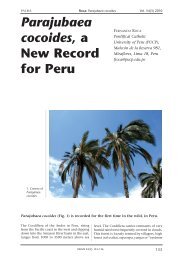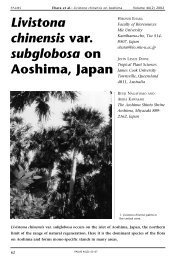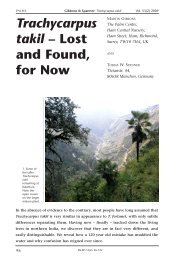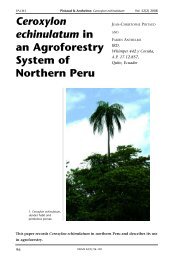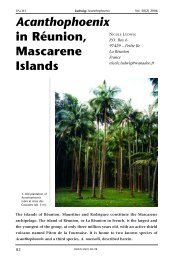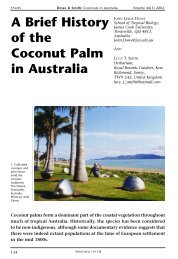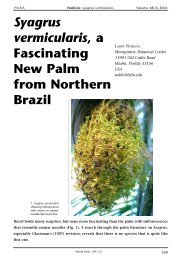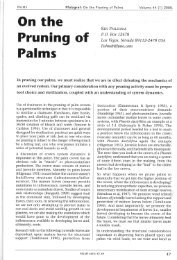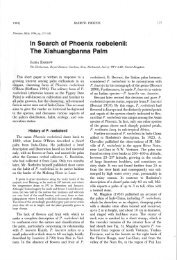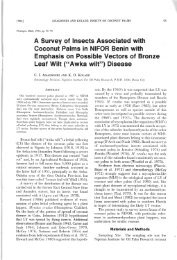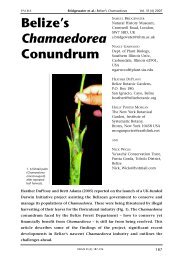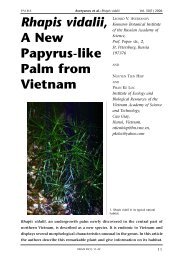The Genus Coccothrinax in Cultivation - International Palm Society
The Genus Coccothrinax in Cultivation - International Palm Society
The Genus Coccothrinax in Cultivation - International Palm Society
You also want an ePaper? Increase the reach of your titles
YUMPU automatically turns print PDFs into web optimized ePapers that Google loves.
PALMS Migliaccio & Reyes: <strong>Coccothr<strong>in</strong>ax</strong> Vol. 49(2) 2005<br />
<strong>The</strong> <strong>Genus</strong><br />
<strong>Coccothr<strong>in</strong>ax</strong><br />
<strong>in</strong> <strong>Cultivation</strong><br />
CHRIS MIGLIACCIO<br />
Dept. of Natural Sciences,<br />
Health & Wellness,<br />
Miami-Dade College,<br />
300 NE 2nd Avenue,<br />
Miami, Florida, 33132<br />
USA<br />
chris.migliaccio@mdc.edu<br />
AND<br />
ARMANDO REYES<br />
3641 SW 21st Street,<br />
Miami, Florida, 33145<br />
USA<br />
kronos5@msn.com<br />
1. A portion<br />
of the<br />
extensive<br />
collection of<br />
<strong>Coccothr<strong>in</strong>ax</strong><br />
at Fairchild<br />
Tropical<br />
Botanic<br />
Garden.<br />
For many years, only a handful of <strong>Coccothr<strong>in</strong>ax</strong> species have ever been cultivated<br />
outside of the Caribbean bas<strong>in</strong>. In the last five years, over two dozen additional<br />
species have become available to collectors. Although little is known about the<br />
needs of these species <strong>in</strong> cultivation, some of these palms are very beautiful and<br />
deserve wider use.<br />
PALMS 49(2): 57–71<br />
57
PALMS Migliaccio & Reyes: <strong>Coccothr<strong>in</strong>ax</strong> Vol. 49(2) 2005<br />
<strong>Palm</strong>s of the genus <strong>Coccothr<strong>in</strong>ax</strong> are species<br />
from coastal scrub and open forest from the<br />
Caribbean islands and border<strong>in</strong>g lands (Uhl &<br />
Dransfield 1987). While most forest species are<br />
found <strong>in</strong> the mid-canopy, a few are emergent<br />
palms. All are solitary, with the exception of<br />
C. pseudorigida and C. fagildei, which cluster.<br />
Currently, there are 50 accepted species <strong>in</strong> the<br />
genus. Considerable taxonomic confusion<br />
exists because many pockets of endemism<br />
occur <strong>in</strong> eastern Cuba, perhaps due to the rich<br />
assemblages of soil types and microclimates,<br />
and most species seem to possess limited<br />
distribution ranges, mak<strong>in</strong>g f<strong>in</strong>d<strong>in</strong>g the palms,<br />
much less collect<strong>in</strong>g ripe seeds, difficult.<br />
When Henderson, Galeano and Bernal<br />
published the Field Guide to the <strong>Palm</strong>s of the<br />
Americas <strong>in</strong> 1995, they reduced the number of<br />
species to 14 and <strong>in</strong>dicated that the genus was<br />
<strong>in</strong> dire need of revision. However, Moya and<br />
Leiva’s checklist (2000) enumerated 38 species<br />
for Cuba alone. When the second largest<br />
center of distribution, Hispaniola, is<br />
considered, the number of accepted species<br />
2. <strong>Coccothr<strong>in</strong>ax</strong><br />
cr<strong>in</strong>ita, a<br />
species known<br />
for its long<br />
fibers cover<strong>in</strong>g<br />
the trunk.<br />
58
PALMS Migliaccio & Reyes: <strong>Coccothr<strong>in</strong>ax</strong> Vol. 49(2) 2005<br />
may be even greater. It is easy to see that this<br />
genus does <strong>in</strong>deed need a great deal of work<br />
to sort out the species. Complicat<strong>in</strong>g matters<br />
further is the fact that anecdotal evidence<br />
strongly suggests that a significant amount of<br />
hybridization has occurred among the species<br />
cultivated <strong>in</strong> South Florida, a situation mak<strong>in</strong>g<br />
taxonomic work based upon these <strong>in</strong>dividuals<br />
challeng<strong>in</strong>g, to say the least. A complete<br />
taxonomic review of <strong>Coccothr<strong>in</strong>ax</strong> would clarify<br />
the taxonomy of exist<strong>in</strong>g species and would be<br />
particularly welcome <strong>in</strong> the light of the current<br />
collect<strong>in</strong>g activity <strong>in</strong> Cuba and the Dom<strong>in</strong>ican<br />
Republic that may very well result <strong>in</strong> the<br />
discovery of new species.<br />
This article focuses on the cultivation of some<br />
of the attractive, but little known, taxa that<br />
have recently come <strong>in</strong>to South Florida. Because<br />
of the confusion regard<strong>in</strong>g names, the<br />
taxonomy of the genus cannot be ignored<br />
completely. This paper thus relies more closely<br />
on the work of Cuban botanists most familiar<br />
with the species <strong>in</strong> the wild than on other<br />
published accounts.<br />
For many years, only a handful of <strong>Coccothr<strong>in</strong>ax</strong><br />
species have ever been cultivated. In this paper,<br />
we def<strong>in</strong>e “cultivation” to mean species found<br />
<strong>in</strong> the landscape trade or <strong>in</strong> private collections<br />
(botanic gardens and <strong>in</strong>dividual collectors).<br />
3. <strong>Coccothr<strong>in</strong>ax</strong><br />
miraguama is<br />
appreciated for its<br />
attractive, persistent<br />
leaf base fibers.<br />
59
PALMS Migliaccio & Reyes: <strong>Coccothr<strong>in</strong>ax</strong> Vol. 49(2) 2005<br />
4. <strong>The</strong> trunk of<br />
<strong>Coccothr<strong>in</strong>ax</strong><br />
spissa is<br />
swollen.<br />
Interest<strong>in</strong>gly, a few species are widely grown,<br />
while the many more species are practically<br />
unknown outside their countries of orig<strong>in</strong>.<br />
Some of these species deserve wider use<br />
because of their beauty.<br />
Presently, only about eight taxa are known to<br />
be grown for the commercial landscape<br />
market; a handful are be<strong>in</strong>g tried <strong>in</strong> the Canary<br />
Islands, but another 30 have gradually begun<br />
to be grown <strong>in</strong> South Florida. Proximity to<br />
wild seed sources, however irregular and<br />
limited <strong>in</strong> quantity, and similar climate and<br />
soil type, make South Florida well suited for<br />
cultivat<strong>in</strong>g and study<strong>in</strong>g the genus. <strong>The</strong>ir slow<br />
growth rate makes them challeng<strong>in</strong>g<br />
candidates for long term study, and for the<br />
same reason, few of the newly available species<br />
are likely to be embraced by the landscape<br />
trade. Several species that have moderately fast<br />
growth rates hold some promise. Warm and<br />
dry regions of Australia and Hawaii could also<br />
be well suited for grow<strong>in</strong>g this genus, but low<br />
soil pH <strong>in</strong> both locations limits <strong>Coccothr<strong>in</strong>ax</strong><br />
cultivation. Few species grow well <strong>in</strong> either<br />
location. Likewise, southern California does<br />
not seem to be a good habitat for most species<br />
because of its long and cool w<strong>in</strong>ters.<br />
For many years, <strong>Coccothr<strong>in</strong>ax</strong> argentata, C.<br />
barbadensis, C. cr<strong>in</strong>ita (Fig. 2), C. miraguama<br />
(Fig. 3) and C. spissa (Fig. 3) were the only<br />
60
PALMS Migliaccio & Reyes: <strong>Coccothr<strong>in</strong>ax</strong> Vol. 49(2) 2005<br />
5. A suspected hybrid between<br />
<strong>Coccothr<strong>in</strong>ax</strong> and Zombia.<br />
species widely found <strong>in</strong> cultivation, although<br />
a handful of names (C. argentea, C. martii, C.<br />
alta) were <strong>in</strong>discrim<strong>in</strong>ately applied to plants<br />
available at local palm sales. Occasionally<br />
plants identified as C. boschiana, C. clarensis,<br />
C. cupularis, C. gracilis, C. fragrans, C. <strong>in</strong>aguensis,<br />
C. jamaicensis, C. readii and C. yuruguana have<br />
been sold at Fairchild Tropical Botanic Garden<br />
or South Florida <strong>Palm</strong> <strong>Society</strong> sales. However,<br />
very few other species have appeared <strong>in</strong><br />
cultivation until the past three years when<br />
collectors from around the Caribbean bas<strong>in</strong><br />
began palm prospect<strong>in</strong>g <strong>in</strong> Cuba and the<br />
Dom<strong>in</strong>ican Republic. As a result, seeds and<br />
seedl<strong>in</strong>gs of numerous taxa have begun to<br />
appear at local palm sales and offered on the<br />
Internet by commercial seed and plant<br />
vendors. However, because the taxonomy is<br />
<strong>in</strong> disarray and there are no mature specimens<br />
of these new “immigrants” <strong>in</strong> South Florida,<br />
it is important to acknowledge that<br />
identification of these newly offered species is<br />
tentative at best. In a few cases, quantities of<br />
“fresh seeds” have been offered from locations<br />
where the palms simply do not exist and/or<br />
many months after the plants f<strong>in</strong>ished their<br />
annual fruit<strong>in</strong>g.<br />
Collections of seeds from palms <strong>in</strong> the type<br />
localities and extensive photo collections have<br />
61
PALMS Migliaccio & Reyes: <strong>Coccothr<strong>in</strong>ax</strong> Vol. 49(2) 2005<br />
Table 1. Species of <strong>Coccothr<strong>in</strong>ax</strong> <strong>in</strong> cultivation.<br />
<strong>Coccothr<strong>in</strong>ax</strong> species Native to Characteristics<br />
argentata P<strong>in</strong>e rocklands of South Florida <strong>in</strong>clud<strong>in</strong>g Florida Lax leaves dark green above and silver below; high<br />
Keys; coastal hammocks of southern Florida Keys; drought and salt tolerance; slow grow<strong>in</strong>g.<br />
Bahamas; Yucatan.<br />
barbadensis Coastal scrub from Lesser Antilles south to Large green leaves, may be slightly silver below;<br />
Tr<strong>in</strong>idad and Margarita Island, Venezuela. fastest grow<strong>in</strong>g of genus (seed to 6 m [20 ft.] <strong>in</strong> ten<br />
years).<br />
borhidiana Scrub forest on karst near coast, Matanzas, Cuba. Exceptionally stiff leaves with short petioles; leaves<br />
reta<strong>in</strong>ed for years – superficially resembl<strong>in</strong>g a<br />
m<strong>in</strong>iature Copernicia macroglossa; erect <strong>in</strong>florescences;<br />
South Florida specimens are f<strong>in</strong>ally produc<strong>in</strong>g large<br />
purple fruit after about 18 years of cultivation from<br />
seed; salt and drought tolerant.<br />
cr<strong>in</strong>ita Low serpent<strong>in</strong>e hill soils <strong>in</strong> central and western Large green leaves; long arch<strong>in</strong>g <strong>in</strong>florescences above<br />
Cuba; critically endangered. the crown with large burgundy fruit; persistent leaf<br />
sheaths form thick layer of fibers on trunk; critically<br />
endangered <strong>in</strong> the wild (
PALMS Migliaccio & Reyes: <strong>Coccothr<strong>in</strong>ax</strong> Vol. 49(2) 2005<br />
6. Community pot<br />
of seedl<strong>in</strong>gs of<br />
Coccoth<strong>in</strong>rax<br />
argentata mak<strong>in</strong>g<br />
vigorous growth.<br />
been made to help identify the plants us<strong>in</strong>g the<br />
older <strong>Coccothr<strong>in</strong>ax</strong> literature. Buyers should<br />
realize that all identifications should be<br />
considered tentative until more extensive field<br />
work is done and the genus is formally revised.<br />
In the meantime, growers should keep accurate<br />
records of seed sources and their own<br />
cultivation experiences to contribute to a<br />
grow<strong>in</strong>g body of <strong>in</strong>formation on this genus of<br />
attractive palms.<br />
In the last few years, small quantities of seeds<br />
and nursery-grown seedl<strong>in</strong>gs labeled as C.<br />
alexandri, C. argentea, C. camagueyana, C.<br />
fragrans, C. ekmanii, C. garciana, C. gundlachii,<br />
C. hiorami, C. macroglossa, C. moaensis, C.<br />
montana, C. munizii, C. borhidana, C. nipensis,<br />
C. pauciramosa, C. pseudorigida, C. salvatoris<br />
and C. saxicola, have become available to<br />
growers. Because these species are “new to the<br />
trade” little is known about their cultural<br />
requirements. This paper, therefore, presents<br />
what is known at this time and identifies what<br />
may be some horticulturally valuable species<br />
worthy of greater use <strong>in</strong> the subtropical and<br />
tropical landscapes.<br />
Species <strong>in</strong> <strong>Cultivation</strong><br />
Because Florida is close to the center of<br />
distribution of the genus and has the wet/dry<br />
season and alkal<strong>in</strong>e soil preferred by most<br />
members of the genus, more <strong>Coccothr<strong>in</strong>ax</strong> (ca.<br />
40 taxa) are cultivated here than anywhere<br />
else. <strong>The</strong> majority of species are recent arrivals,<br />
and few fruit<strong>in</strong>g specimens exist. Anecdotal<br />
evidence suggests that what have been<br />
recognized as <strong>Coccothr<strong>in</strong>ax</strong> species (particularly<br />
those <strong>in</strong> the C. argentata – C. readii – C.<br />
<strong>in</strong>aguensis – C. litoralis and C. barbadensis – C.<br />
alta – C. readii – C. proctorii – C. jamaicensis<br />
groups outside of Cuba) can form fertile<br />
hybrids. This evidence suggests that each<br />
63
PALMS Migliaccio & Reyes: <strong>Coccothr<strong>in</strong>ax</strong> Vol. 49(2) 2005<br />
group may be one species that displays a wide<br />
range of characteristics across its range rather<br />
than a guild of multiple species. Additionally,<br />
an <strong>in</strong>tergeneric and sterile <strong>Coccothr<strong>in</strong>ax</strong> ×<br />
Zombia hybrid has flourished at Fairchild<br />
Tropical Botanic Garden <strong>in</strong> Miami for decades<br />
(Fig 5). Obviously the application of DNA<br />
analysis to all <strong>Coccothr<strong>in</strong>ax</strong> could help clarify<br />
the picture.<br />
Table 1 presents the species that have been<br />
grown for the longest time <strong>in</strong> South Florida,<br />
as well as <strong>in</strong> Hawaii, Australia, the Canary<br />
Islands and elsewhere. <strong>Palm</strong>s known as C. alta<br />
and C. argentea are also <strong>in</strong> cultivation, but all<br />
the mature plants the authors have seen have<br />
horticultural orig<strong>in</strong>s and resemble either C.<br />
argentata or C. barbadensis, or share a mixture<br />
of characteristics that make identification<br />
challeng<strong>in</strong>g.<br />
Cultivat<strong>in</strong>g <strong>Coccothr<strong>in</strong>ax</strong><br />
<strong>Coccothr<strong>in</strong>ax</strong> are best grown from freshly<br />
collected ripe seeds. After remov<strong>in</strong>g the pulp,<br />
soak the seeds 1–3 days and discard any<br />
“floaters.” Dried seeds may be soaked for over<br />
a week to rehydrate them. Sow the seeds<br />
shallowly <strong>in</strong> a 10–15 cm deep community pot<br />
of well dra<strong>in</strong>ed medium kept <strong>in</strong> a warm, sunny<br />
space. Fresh seeds germ<strong>in</strong>ate best, but seeds<br />
can take up to a year to germ<strong>in</strong>ate. Be patient<br />
and do not throw the seeds out until they rot.<br />
If the soil mix breaks down, remove the<br />
ungerm<strong>in</strong>ated seeds, replace the mix and<br />
resow.<br />
7. <strong>The</strong> root<br />
mass of<br />
<strong>Coccothr<strong>in</strong>ax</strong><br />
hiorami is<br />
large and<br />
benefits from<br />
a large,<br />
roomy pot.<br />
64
PALMS Migliaccio & Reyes: <strong>Coccothr<strong>in</strong>ax</strong> Vol. 49(2) 2005<br />
8. <strong>Coccothr<strong>in</strong>ax</strong><br />
boschiana is<br />
slow-grow<strong>in</strong>g<br />
but attractive,<br />
even as a<br />
young plant.<br />
Community pots may be divided when<br />
seedl<strong>in</strong>gs are at the two-leaf stage. Seedl<strong>in</strong>gs<br />
should be placed <strong>in</strong> pots deep enough to<br />
accommodate the long roots (Fig. 6)<br />
<strong>Coccothr<strong>in</strong>ax</strong> germ<strong>in</strong>ates remotely, so be sure to<br />
plant the seedl<strong>in</strong>g so the roots are below the<br />
soil and the bud of the seedl<strong>in</strong>g is above<br />
ground. Once aga<strong>in</strong>, a well-dra<strong>in</strong>ed medium is<br />
best and may be amended with crushed<br />
limestone rock or dolomite for dra<strong>in</strong>age and<br />
to ma<strong>in</strong>ta<strong>in</strong> an alkal<strong>in</strong>e root zone.<br />
<strong>Coccothr<strong>in</strong>ax</strong> benefits from over-pott<strong>in</strong>g – that<br />
is, plant<strong>in</strong>g <strong>in</strong> larger pots than most palms,<br />
because of their proportionately greater root<br />
mass (Fig. 7). Growth rates can be <strong>in</strong>creased by<br />
mov<strong>in</strong>g seedl<strong>in</strong>gs and juvenile plants <strong>in</strong>to pots<br />
one size greater than the usual sequence. Keep<br />
potted <strong>Coccothr<strong>in</strong>ax</strong> off the ground on benches<br />
to ensure good air circulation around the<br />
plants. Most species (except C. cr<strong>in</strong>ita, C.<br />
montana and C. yunquensis) will tolerate full<br />
sun even as seedl<strong>in</strong>gs. Growers <strong>in</strong> subtropical<br />
65
PALMS Migliaccio & Reyes: <strong>Coccothr<strong>in</strong>ax</strong> Vol. 49(2) 2005<br />
9. <strong>Coccothr<strong>in</strong>ax</strong> borhidiana is a handsome palm for gardens.<br />
regions will also need to provide cold<br />
protection for these small potted palms,<br />
especially from dry w<strong>in</strong>ds and cold ra<strong>in</strong> that<br />
encourage fatal fungal <strong>in</strong>fections. Regular<br />
applications of a balanced time release palm<br />
fertilizer and micronutrient sprays will also<br />
promote growth and strengthen plants aga<strong>in</strong>st<br />
conditions of low humidity and cool w<strong>in</strong>ter<br />
temperature. Patience is also a requirement for<br />
grow<strong>in</strong>g palms <strong>in</strong> this genus as most are slowgrow<strong>in</strong>g,<br />
particularly for the first 3–5 years.<br />
Because most species are found <strong>in</strong> sunny,<br />
seasonally dry climates and <strong>in</strong> well dra<strong>in</strong>ed<br />
alkal<strong>in</strong>e soils, similar landscape conditions will<br />
promote the best growth when the palms are<br />
ready to be planted. Dig a large hole to<br />
accommodate future root growth and then<br />
water and mulch the newly planted palms to<br />
mimic their habitat. Plant<strong>in</strong>g at the beg<strong>in</strong>n<strong>in</strong>g<br />
of the ra<strong>in</strong>y season will help young plants get<br />
established. Keep mulch away from the trunk<br />
to avoid fungal <strong>in</strong>fection and fertilize lightly<br />
66
PALMS Migliaccio & Reyes: <strong>Coccothr<strong>in</strong>ax</strong> Vol. 49(2) 2005<br />
10. <strong>Coccothr<strong>in</strong>ax</strong> camagueyana has silvery leaves with bluish cast.<br />
for the first six months with a palm fertilizer<br />
with N-P-K ratio of 2-1-3 and micronutrients.<br />
Liquid fertilizers may be used for plants <strong>in</strong> the<br />
ground or <strong>in</strong> pots but are unlikely to have<br />
much effect on slow-grow<strong>in</strong>g palms such as<br />
these.<br />
Many of the very attractive Cuban species are<br />
found <strong>in</strong> serpent<strong>in</strong>e soils rich <strong>in</strong> nickel and/or<br />
other heavy metals such as iron, chromium,<br />
cobalt and manganese. <strong>The</strong>se soils also feature<br />
high magnesium/calcium ratios with<br />
correspond<strong>in</strong>gly low levels of calcium,<br />
potassium and phosphorus. In fact, calcium<br />
levels <strong>in</strong> serpent<strong>in</strong>e soils are virtually zero.<br />
Serpent<strong>in</strong>e soils can be either acidic or alkal<strong>in</strong>e<br />
with older serpent<strong>in</strong>e areas tend<strong>in</strong>g to be more<br />
acidic and newer ones slightly more alkal<strong>in</strong>e.<br />
For the serpent<strong>in</strong>e species (C. sp. “azul”, C.<br />
camagueyana, C. clarensis, C. garciana, C.<br />
moaensis, C. pseudorigida and C. yuruguana)<br />
long-term conta<strong>in</strong>er culture may be the only<br />
viable option unless local soils are serpent<strong>in</strong>e<br />
67
PALMS Migliaccio & Reyes: <strong>Coccothr<strong>in</strong>ax</strong> Vol. 49(2) 2005<br />
as well. Alternatively, us<strong>in</strong>g an iron and<br />
magnesium amendment once a month seems<br />
beneficial.<br />
Species worthy of wider cultivation<br />
<strong>The</strong> follow<strong>in</strong>g species are worthy of wider<br />
cultivation because of the characteristics listed<br />
and their prospective adaptability to<br />
subtropical or tropical conditions on well<br />
dra<strong>in</strong>ed alkal<strong>in</strong>e soils.<br />
C. alexandri – 13–20 m, robust, Cuban, coastal<br />
palm with large crown of stiff leaves with silver<br />
undersides.<br />
C. boschiana (Fig. 8) – slender, Dom<strong>in</strong>ican<br />
Republic, coastal species with leaves golden<br />
green above and silver below; heavy, coarse<br />
fiber; slow-grow<strong>in</strong>g.<br />
C. brevicr<strong>in</strong>is – Cuban palm with short trunk,<br />
short, coarse fibers and dense crown<br />
<strong>in</strong>termediate <strong>in</strong> “hair<strong>in</strong>ess” between C.<br />
borhidiana (Fig. 9) and C. cr<strong>in</strong>ita (Fig. 2); from<br />
a different part of Cuba with different soil (C.<br />
cr<strong>in</strong>ita comes from serpent<strong>in</strong>e area, C.<br />
brevicr<strong>in</strong>is from alkal<strong>in</strong>e calcareous soils.<br />
C. camagueyana (Fig. 10) – drought tolerant,<br />
serpent<strong>in</strong>e species good for pot culture,<br />
moderate growth rate, stiff leaves with silverblue<br />
cast on upper surface; similar to plants<br />
known as C. “azul” (Fig. 11).<br />
C. fragrans – Dom<strong>in</strong>ican Republic and Cuban<br />
species with stout trunk; close aff<strong>in</strong>ity to C.<br />
spissa.<br />
C. garciana – serpent<strong>in</strong>e species from Cuba with<br />
sp<strong>in</strong>y red leaf fibers to 2 cm wide, rigid round<br />
leaves on short petioles; exceptionally slow<br />
growth rate and soil requirements may limit<br />
this to long-term pot culture.<br />
C. gundlachii – robust, Cuban species with<br />
large, stiff leaves, erect <strong>in</strong>florescence and heavy,<br />
coarse fiber.<br />
C. litoralis – coastal Cuban species found <strong>in</strong><br />
sandy, wet, littoral scrub; high salt tolerance<br />
and moderate growth rate.<br />
C. macroglossa (Fig. 12) – robust, Cuban palm<br />
with large black fruit, stiff leaves that are silver<br />
underneath, coarse fibers.<br />
C. montana – an understory palm from the<br />
moist mounta<strong>in</strong>s of the central Dom<strong>in</strong>ican<br />
Republic; dark green leaves deeply divided;<br />
fast-grow<strong>in</strong>g; white fruit.<br />
11. <strong>The</strong> species known to growers as <strong>Coccothr<strong>in</strong>ax</strong> “azul” is one of the bluest species.<br />
68
PALMS Migliaccio & Reyes: <strong>Coccothr<strong>in</strong>ax</strong> Vol. 49(2) 2005<br />
12. <strong>Coccothr<strong>in</strong>ax</strong> macroglossa has stiff leaves that are silvery underneath.<br />
C. munizii (Fig. 13) – a th<strong>in</strong>-stemmed, Cuban<br />
species with small, wedge-shaped leaves; t<strong>in</strong>y<br />
fruit; a good plant<strong>in</strong>g companion with cactus.<br />
C. pauciramosa – medium-sized, coastal, Cuban<br />
species with erect <strong>in</strong>florescence and heavy,<br />
coarse fiber; easy to cultivate.<br />
C. salvatoris – Cuban brackish forest species<br />
with a compact crown, wide leaf segments,<br />
heavy fiber and starburst-like leaves.<br />
Many questions rema<strong>in</strong><br />
A handful of other species (C. clarensis, C.<br />
cupularis (Fig. 14), C. ekmanii, C.<br />
guantanamensis, C. hiorami, C. <strong>in</strong>aguensis, C.<br />
jamaicensis, C. pseudorigida, C. readii, C. saxicola,<br />
C. yunquensis, and C. yuraguana) are so poorly<br />
represented <strong>in</strong> cultivation that identification<br />
of some of the plants may be questionable,<br />
particularly if the plants were grown from<br />
seeds collected <strong>in</strong> botanic gardens.<br />
Furthermore, the follow<strong>in</strong>g taxa rema<strong>in</strong> poorly<br />
known altogether or unknown <strong>in</strong> cultivation<br />
outside their country of orig<strong>in</strong> (Cuba, unless<br />
otherwise noted): C. acunana, C. baracoensis, C.<br />
bermudezii, C. concolor (Haiti, ext<strong>in</strong>ct?), C.<br />
elegans, C. fagildei (cluster<strong>in</strong>g with up to 100<br />
heads!), C. leonis, C. microphylla, C. moaensis,<br />
C. muricata, C. nipensis, C. orientalis, C. pumila,<br />
C. rigida, C. savannarum, C. tr<strong>in</strong>itensis, and C.<br />
victor<strong>in</strong>i) that their horticultural potential<br />
cannot be evaluated at this time.<br />
A further comment<br />
As we worked on this article, we realized that<br />
cultivat<strong>in</strong>g <strong>Coccothr<strong>in</strong>ax</strong> serves as a metaphor<br />
of life itself and offers many mean<strong>in</strong>gful<br />
lessons – patience is an important virtue,<br />
actions often take a long time to bear fruit and<br />
no matter how much we would like to see<br />
th<strong>in</strong>gs happen, Nature moves accord<strong>in</strong>g to its<br />
own timetable. <strong>Coccothr<strong>in</strong>ax</strong> seedl<strong>in</strong>gs need the<br />
right nutrients, just the right amount of water<br />
and sunlight and a healthy environment. <strong>The</strong>y<br />
can tolerate a fair amount of pests, <strong>in</strong>clud<strong>in</strong>g<br />
overprotective “parents.” Whenever our<br />
conversation turns to which species just<br />
produced its first divided leaf after years of<br />
growth, we are rem<strong>in</strong>ded of these lessons.<br />
69
PALMS Migliaccio & Reyes: <strong>Coccothr<strong>in</strong>ax</strong> Vol. 49(2) 2005<br />
13. <strong>Coccothr<strong>in</strong>ax</strong> munizii is a<br />
slender palm with stiff<br />
leaves from the driest part<br />
of southeastern Cuba.<br />
Summary<br />
As more species of <strong>Coccothr<strong>in</strong>ax</strong> are cultivated,<br />
we hope that commercial growers and<br />
collectors will share their experiences <strong>in</strong> palm<br />
forums and <strong>in</strong> the literature so that these<br />
attractive palms will f<strong>in</strong>d greater use <strong>in</strong><br />
landscapes. We hope to see more <strong>in</strong> situ and<br />
ex situ conservation efforts, particularly for the<br />
Cuban species with limited distributions, <strong>in</strong><br />
order to buffer the effects of human activity,<br />
particularly coastal tourism, <strong>in</strong> Cuba and the<br />
Dom<strong>in</strong>ican Republic. Additionally, consistent<br />
practice of susta<strong>in</strong>able collection techniques<br />
and appropriate horticultural methods can also<br />
ensure the survival of <strong>Coccothr<strong>in</strong>ax</strong> <strong>in</strong> the wild<br />
and <strong>in</strong> cultivation. <strong>The</strong>se practices <strong>in</strong>clude<br />
collect<strong>in</strong>g a few seeds from many <strong>in</strong>dividuals<br />
rather than all the seeds of a few specimens,<br />
harvest<strong>in</strong>g only ripe seeds and process<strong>in</strong>g them<br />
promptly, match<strong>in</strong>g the cultural conditions to<br />
the plant’s own habitat as closely as possible,<br />
as well as carefully monitor<strong>in</strong>g these palms<br />
from sow<strong>in</strong>g to plant<strong>in</strong>g <strong>in</strong> the landscape. It<br />
is particularly important to obta<strong>in</strong> as much<br />
knowledge as possible of the ecology of these<br />
palms <strong>in</strong> the wild, as this <strong>in</strong>formation will help<br />
us determ<strong>in</strong>e each species’ suitability for<br />
cultivation and techniques of conservation.<br />
Acknowledgments<br />
<strong>The</strong> authors thank Dr. Scott Zona, <strong>Palm</strong><br />
Biologist at Fairchild Tropical Botanic Garden<br />
70
PALMS Migliaccio & Reyes: <strong>Coccothr<strong>in</strong>ax</strong> Vol. 49(2) 2005<br />
14. <strong>Coccothr<strong>in</strong>ax</strong><br />
cupularis is still<br />
uncommon outside<br />
botanical gardens. This<br />
specimen grows at<br />
Fairchild Tropical<br />
Botanic Garden, Miami,<br />
Florida.<br />
and Paul Craft, President of IPS for their<br />
ongo<strong>in</strong>g encouragement of this project,<br />
assistance with translations of orig<strong>in</strong>al<br />
descriptions and their editorial suggestions.<br />
Many collectors and horticulturalists k<strong>in</strong>dly<br />
shared their experiences; notable among them<br />
were Mike Harris, Loxahatchee, Florida, USA;<br />
Dale Holton, Lake Worth, Florida, USA; Marcel<br />
Moreno, Miami, Florida, USA; Ken Neugent<br />
and Mike Davenport, Fairchild Tropical<br />
Botanic Garden, Miami, Florida, USA; Carlo<br />
Morici, Tenerife, Canary Islands; and the late<br />
Howard Waddell, Miami, Florida USA. All<br />
photos were taken by Chris Migliaccio unless<br />
otherwise noted.<br />
LITERATURE CITED<br />
MOYA L., C.E. AND A. T. LEIVA S. 2000. Checklist<br />
of the palms of Cuba, with notes on their<br />
ecology, distribution and conservation.<br />
<strong>Palm</strong>s 44: 69–84.<br />
71



